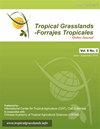印度半干旱热带地区放牧强度和牧场类型对土壤有机碳储量的影响
IF 0.7
4区 农林科学
Q3 AGRICULTURE, DAIRY & ANIMAL SCIENCE
引用次数: 0
摘要
根据放牧压力和管理做法,牧场可作为碳源和碳汇。对印度半干旱热带地区5、10和15只羊/ha的播种、改良和天然牧场3种不同放牧强度下的土壤有机碳储量及其组分进行了定量研究。结果表明:改良牧草3年后颗粒有机碳(POC ~4.5 g/kg)、有机碳(~ 0.53%)、总有机碳(TOC~7 g/kg)和有机碳储量(~15 mg/ha)显著高于播种牧草和天然牧草;土壤微生物生物量碳(SMBC ~378µg/g土壤)和活性碳(LC ~185 mg/kg土壤)均高于天然草地。10羊/ha的中等放牧强度显著提高了土壤碳组分、TOC和SOC储量。表层土壤有机碳储量及其组分显著高于下层土壤。上述结果表明,在半干旱热带草原,适宜适度放牧强度的改良放牧方式可提高土壤有机碳储量及其组分。本文章由计算机程序翻译,如有差异,请以英文原文为准。
Effects of grazing intensity and pasture type on soil organic carbon stock in the semi-arid tropics of India
Pastures may act as carbon sources and sinks depending on grazing pressure and management practices. Soil organic carbon (SOC) stock and its fractions were quantified under 3 different grazing intensities using 5, 10 and 15 sheep/ha under sown, improved and natural pastures in the semi-arid tropics of India. Results revealed that after 3 years, improved pasture had significantly higher particulate organic carbon (POC ~4.5 g/kg), SOC (~0.53 %), total organic carbon (TOC~7 g/kg) and SOC stock (~15 mg/ha) as compared with sown and natural pastures. Labile carbon (LC ~185 mg/kg) and soil microbial biomass carbon (SMBC ~378 µg/g soil) were higher under natural pasture. A moderate grazing intensity of 10 sheep/ha resulted in significantly greater carbon fractions, TOC and SOC stock. SOC stock and its fractions were significantly higher in the topsoil layers as compared with the subsoil layers. These results indicate that improved pasture management practices with moderate grazing intensity can be recommended for improving SOC stock and its fractions in semi-arid tropical pastures.
求助全文
通过发布文献求助,成功后即可免费获取论文全文。
去求助
来源期刊

Tropical Grasslands-Forrajes Tropicales
Agricultural and Biological Sciences-Agronomy and Crop Science
CiteScore
1.60
自引率
0.00%
发文量
36
审稿时长
16 weeks
期刊介绍:
The Journal publishes, in English or Spanish, Research Papers and Short Communications on research and development, as well as contributions from practitioners (Farmer Contributions) and Review Articles, related to pastures and forages in the tropics and subtropics. There is no regional focus; the information published should be of interest to a wide readership, encomprising researchers, academics, students, technicians, development workers and farmers.
In general, the focus of the Journal is more on sown (''improved'') pastures and forages than on rangeland-specific aspects of natural grasslands, but exceptions are possible (e.g. when a submission is relevant for a particularly broad readership in the pasture and forage science community).
The Journal will also consider the occasional publication of associated, but closely related, research in the form of an additional scientific communication platform [e.g. a re-make of the former Genetic Resources Communication series of the former Division of Tropical Crops and Pastures of the Commonwealth Scientific and Industrial Research Organisation (CSIRO), Australia].
Areas of particular interest to the Journal are:
Forage Genetic Resources and Livestock Production[...]
Environmental Functions of Forages[...]
Socio-economic Aspects[...]
Topics within the aforementioned areas may include: Diversity evaluation; Agronomy; Establishment (including fertilization); Management and utilization; Animal production; Nutritive value; Biotic stresses (pests and diseases, weeds); Abiotic stresses (soil fertility, water, temperature); Genetics and breeding; Biogeography and germplasm collections; Seed production; Ecology; Physiology; Rhizobiology (including BNF, BNI, mycorrhizae); Forage conservation; Economics; Multilocational experimentation; Modelling.
 求助内容:
求助内容: 应助结果提醒方式:
应助结果提醒方式:


